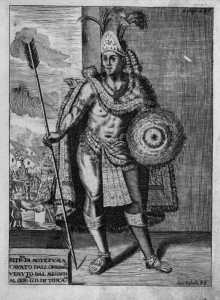
Moctezuma II ascended the throne of Tenochtitlán in 1502 when 22 years old
The first Spanish expedition to the coast of Mexico started in 1517. A strong Spanish troop contingent left Cuba and reached the Yucatan peninsula. By 1518 it is believed that the total population of native people in Central Mexico was around 25 millions.
Bernardino de Sahagun started a Franciscan mission in Mexico and started to write the first history of the Aztecs. He trained Mexican people to write down the oral histories of Atzecs life, religion, and beliefs before Cortés’ arrival. The result of this work is his book the “Florentine Codex” or a “General History of the Things of New Spain”.
In 1519-1521 Hernando Cortès and 400 Spaniards landed on the Yucatan coast and the destruction of the Aztec Empire began. It is not yet understood how such a small army was able to defeat the empire of 200,000 Azteca with 50,000 men of arms. The theory that Montezuma mistook Cortès –who had burned his ships- for the god Quetzalcoatl is the best guess.
The battle of Tenochtitlan –a city built on a lake with many gardens, pyramids and canals- was the first step of Cortès’ conquest. Cortès made an alliance with the Tlaxcalas and entered Tenochtitlan easily. He took Montezuma hostage and looted his palace of gold and treasure. The Aztecs revolted and Cortès had to leave the city. The Aztecs could have obliterated the Spanish but they did not as this concept was unknown to them.
The second battle of Tenochtitlan took place in 1521 after that the plague had ravaged the city. A new king, Cuitlahhuac, replaced Montezuma. The Aztecs thought that the Spanish were finished but this was not thecae. Cortès and his men rested with the Tlaxcalas and made friends with the city-state Texcoco. A new battle against Tenochtitlan started and although the Aztecs had also reorganised they had to surrender after a four month siege. The plague killed the new king and many of his men and the Aztecs were powerless against the well-organised Spanish.
In 1531, Guadalupe, the black Virgin Mary, appeared to Juan Diego, and Indian acolyte near Mexico City. In his vision she was a mestizo. The day of the Virgin of Guadalupe is celebrated on December 12.
In 1531 the Yaqui Indians of northern Mexico repelled a party of Spanish soldiers on a slaving mission.
Coronado came back to Mexico empty handed. All he found were the dwellings of the Wichita Indians. He left horses and sheep in the pueblos. Coronado was sent back to Spain to a trial for mismanagement of his army and cruelty to the Indians.
Bernardino de Sahagun study of the Aztec History before the Spanish arrival, the result of 30 years of work with the native Indians, produced, in 1560, a different view of the official one produced by the Church and the crown. The Spanish governor of the Indies did not censor Sahagun’s work but the project came soon to a close.
In 1577 Sahagun’s work was declared illegal. The Inquisition ordered all that all pre-Columbian works in New Spain to be delivered to them. The Governor of the Indies who had protected Sahagun’s work was removed from office and replaced by an Inquisition Governor who did not like Sahagun’s work and when he protested the destruction of his life’s work he was excommunicated. Sahagun accepted the decision and he gave copies of his books to father Seguera, a Franciscan general commissioner, to be sent to Spain and the Inquisition. They never arrived there bur surfaced in Florence, Italy and survived under the name of “Florentine Codex”.


Be First to Comment